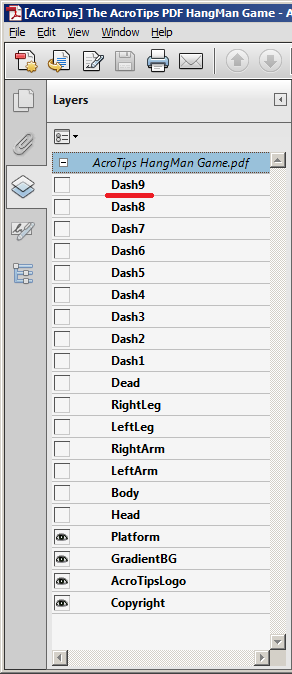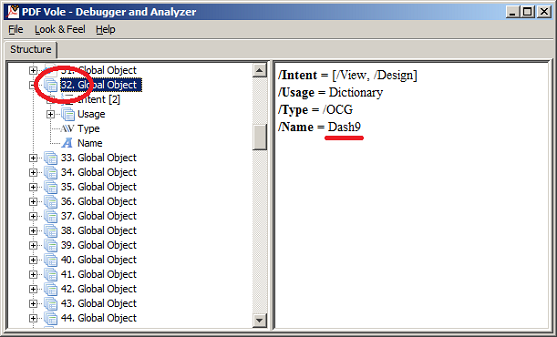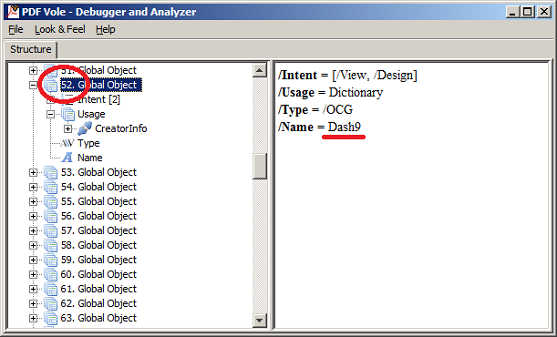| Prev |  | Next |
The content of a PDF document can be arranged in multiple layers. Section 8.11.2.1 of the PDF specification “PDF 32000-1:2008” says: “An optional content group is a dictionary representing a collection of graphics that can be made visible or invisible dynamically by users of conforming readers.”.
Adobe Reader® uses the term “Layer” and the specification uses the term “OCG”. They are equivalent.
PDFUnit provides the following tags to test layers:
<!-- Tags to test layers: --> <!-- 'Layer' means the same as 'OCG, Optional Content Group'. So they have the same type: --> <hasNumberOfLayers />, <hasNumberOfOCGs /> <!-- Nested tags: --> <hasLayer> or <hasOCG> <withName> (required) <matchingComplete /> (one of these nested tags ... <containing /> ... <startingWith /> ... is required) </withName> </hasLayer> or </hasOCG> <hasLayers> or <hasOCGs> <allWithoutDuplicateNames /> (optional) </hasLayers> or </hasOCGs>
The tag <endingWith /> is not provided
because duplicate layer names are expanded internally with a suffix and thus the end of
a name is not predictable.
A tag matchingRegex /> is also not provided
because layer names are usually short.
The first tests check the number of existing layers (OCGs):
<testcase name="hasNumberOfOCGs"> <assertThat testDocument="layer/hang-man-game.pdf"> <hasNumberOfOCGs>40</hasNumberOfOCGs><hasNumberOfLayers>40</hasNumberOfLayers>
</assertThat> </testcase>
The next example tests the name of a layer:
<testcase name="hasLayerWithName_MatchingComplete"> <assertThat testDocument="layer/simpleLayerDemo.pdf"> <hasLayer> <withName> <matchingComplete>Parent Layer</matchingComplete> </withName> </hasLayer> </assertThat> </testcase>
The tags endingWith /> and matchingRegex />
are intentionally not provided as explained at the beginning of this chapter.
String comparisons are case-insensitive. Whitespaces remain unchanged.
<!-- Layer names are treated case-insensitive. --> <testcase name="hasLayerWithName_CaseInSensitive"> <assertThat testDocument="layer/simpleLayerDemo.pdf"> <hasLayer> <withName> <matchingComplete>parent layer</matchingComplete> </withName> </hasLayer> <hasLayer> <withName> <matchingComplete>Parent Layer</matchingComplete> </withName> </hasLayer> </assertThat> </testcase>
According to the PDF standard, layer names are not necessarily unique. The document of the next example contains duplicate layer names. They can not be seen with Adobe Reader®. Use “PDFVole” instead. shows them:
| Layer Names in Adobe Reader® | Layer Objects in PDFVole |
|---|---|
 |
  |
You can see clearly that the layer objects with the numbers 32 and 52 have the same name “Dash9”.
PDFUnit provides a tag to verify that a document has no duplicate layer names:
<testcase name="hasLayers_AllWithoutDuplicateNames"> <assertThat testDocument="layer/simpleLayerDemo.pdf"> <hasLayers> <allWithoutDuplicateNames /> </hasLayers> <hasOCGs> <!-- <hasOCGs /> is equal to <hasLayers /> --> <allWithoutDuplicateNames /> </hasOCGs> </assertThat> </testcase>
In the current release 2015.10 PDFUnit does not provide functions to verify the content of a single layer.